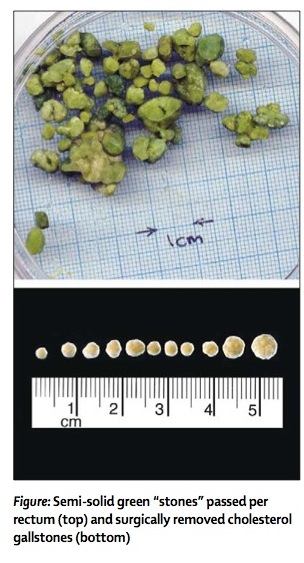
膽結石,膽囊炎是一種初期很像胃痛,但是其實隱藏著危險的疾病
網路上盛傳某些奇特的排膽結石的療法:
第1~5天
‧每日5顆蘋果,飲食清淡少油,
‧蘋果青紅不拘,如果是比較大的蘋果,可以吃少些(比如富士蘋果只吃3顆)。
‧可打成蘋果汁,每日飲用1000cc。
‧吃蘋果是為了軟化結石。
第6天
不吃蘋果,飲食清淡少油,過午不食
6pm :喝一小匙瀉鹽加溫水(可用西柚汁/蘋果汁代清水,較易入口。)
8pm :喝一小匙瀉鹽加溫水
10 pm:半杯鮮榨檸檬汁+半杯食用橄欖油混合一次慢慢喝完
(可用西柚汁代檸檬汁,好處是更易混合,喝後馬上上床睡覺)
‧瀉鹽→放鬆膽管,橄欖油→促使大量分泌膽汁,沖出結石。
‧次日(甚或當晚)開始排出青黑色糞便,結石會浮在水面上,可挑起存證。
‧若第一次排出很多結石,可數月後再做一次清除剩下的。
‧一般人可一年一次,預防結石。
而且這種怪方法還不只一種:
排肝毒和排膽石的療程分別為10天和6天,但建議一次過同時進行,也就是在排肝毒療程進行到第5天時,加入排膽石的療程。
排肝毒(10天療程)
第一至十天
準備飲料
‧溫開水──3/4杯
‧糖蜜(molasses)──1湯匙
‧檸檬汁──2湯匙
‧紅椒粉(cayenne pepper)──1/4茶匙
‧橄欖油(olive oil)──1茶匙
持續10天,在早上5點至7點之間,將以上的材料加在一起攪拌均勻,然後空腹喝下。
排膽石(6天療程)
從第五天開始每天飲用1公斤的蘋果汁(每次一杯),直到第10天。
第十天
請注意:
‧在下午4點前喝完最後一杯蘋果汁。
‧5pm:晚餐
‧6pm:喝一杯溫開水+一茶匙瀉鹽
‧8pm:喝一杯溫開水+一茶匙瀉鹽
‧10pm:喝半杯(100ml)檸檬汁+半杯(100ml)橄欖油
‧上床睡覺(向著右側)
第十天半夜或第十一天早上
‧排便。
‧排便時用篩子裝起糞便,然後用水沖掉糞便。若有膽石排出,就可以看見一顆顆的固體留在篩子裡。
非常可怕,如果你試過一次就會知道,這種方式會讓你非常不舒服,剛好Lancet也有人對這個方法產生疑惑,就看他們的解釋吧:
A 40-year-old woman was referred to the outpatient clinic with a 3-month history of recurrent severe right hypochondrial pain after fatty food. Abdominal ultrasound showed multiple 1–2 mm gallstones in the gall- bladder.
She had recently followed a “liver cleansing” regime on the advice of a herbalist. This regime consisted of free intake of apple and vegetable juice until 1800 h, but no food, followed by the consumption of 600 mL of olive oil and 300 mL of lemon juice over several hours. This activity resulted in the pain
less passage of multiple semisolid green “stones” per rectum in the early hours of the next morning. She col- lected them, stored them in the freezer, and presented them in the clinic (figure).
Microscopic examination of our patient’s stones revealed that they lacked any crystalline structure, melted to an oily green liquid after 10 min at 40oC, and contained no cholesterol, bilirubin, or calcium by established wet chemical methods.1 Traditional faecal fat extraction techniques2 indicated that the stones contained fatty acids that required acid hydrolysis to give free fatty acids before extraction into ether. These fatty acids accounted for 75% of the original material.
Experimentation revealed that mixing equal volumes of oleic acid (the major component of olive oil) and lemon juice produced several semi solid white balls after the addition of a small volume of a potassium hydroxide solution. On air drying at room tem- perature, these balls became quite solid and hard.
We conclude, therefore, that these green “stones” resulted from the
action of gastric lipases on the simple and mixed triacylglycerols that make up olive oil, yielding long chain car- boxylic acids (mainly oleic acid). This process was followed by saponification into large insoluble micelles of potas- sium carboxylates (lemon juice con- tains a high concentration of potassium) or “soap stones”. The cho- lesterol stones noted on ultrasound were removed by surgery (figure).
A search of the internet reveals many health websites promoting so- called “gall-bladder flushing” or “liver cleansing” regimes. Some quote a Correspondence letter published in The Lancet3 on the subject. The 1-day purge usually consists of an overnight fast, then eating apples in the morn- ing, taking only herbal tea through the day, and then in the evening a warm mixture of olive oil (2/3 cup) and fresh lemon juice (1/3 cup). Patients are instructed to then lie on the right side (although some say the left). It is claimed that the next morn- ing the gallstones will pass in the stool.
We have shown that these flushing regimes for expelling gallstones are a myth, and that the claims made by some are misleading. The appearance of a letter in an establishment journal has been used to legitimise this prac- tice for some time and the record should now be set straight.
Clinical Biochemistry Unit, Canterbury Health Laboratories, PO Box 151, Christchurch, New Zealand (CWS); and Gastroenterology Department, Waikato Hospital, Hamilton, New Zealand (JB)
- Steen G, Blijenberg BG. Chemical analysis of gallstones. Eur J Clin Chem Clin Biochem 1991; 29: 801–04.
- Varley H. Practical clinical biochemistry, 4th edn. London: Whitfriars Press, 1967.
- Dekkers R. Apple juice and the chemical-contact softening of gallstones. Lancet 1999; 354: 2171.
結論就是:你在你的身體進行了皂化反應,於是創造了一堆皂石。
何謂皂化反應呢?
其實就是:鹼(通常為強鹼)催化下的酯被水解,而生產出醇和羧酸鹽,尤指油脂的水解。
或是狹義的講,皂化反應僅限於油脂與氫氧化鈉或氫氧化鉀混合,得到高級脂肪酸的鈉/鉀鹽和甘油的反應。
化學過程惟:甘油酯+氫氧化鈉得到肥皂

R基可能不同,但生成的R-COONa都可以做肥皂。
但是喝下去的都是酸呀,那鹼從何而來?
讓我告訴大家腸胃道內的酸鹼值:
| 消化液 | pH |
| 胃液 | 1~2 |
| 小腸液 | 7.6 |
| 膽汁 | 7-7.4 |
| 胰液 | 7.1-8.2 |
這樣大家就可以理解為什麼會有造化的反應了。
但是為什麼有些人會說他也是這樣嘗試,但是對他的腹痛確實有比較好了呢?
原因是出在蘋果酸和你那幾天的生活習慣:
- 因為蘋果酸有很輕微的膽囊括約肌鬆弛效果,非常微弱,但是對於極小顆的膽時或是膽泥濃縮的患者來說,卻有一點點解救燃眉之急的效果。
- 當然,膽的疼痛會暫時解除,其實跟你進行療法期間的飲食有關係,因為進行排石療法的那幾天,你減少了高油脂的飲食,所以對膽囊來說,也算是減輕了工作量,自然就有恢復的時間。
只不過,對於大小超過膽道的結石來說,不管是飲食還是蘋果酸,都是無濟於事的,因此最好的方式還是:
去看診尋求醫師的意見,看是要使用藥物治療還是進行切除,不要再網路上找偏方給自己找罪受





 留言列表
留言列表
 線上藥物查詢
線上藥物查詢 